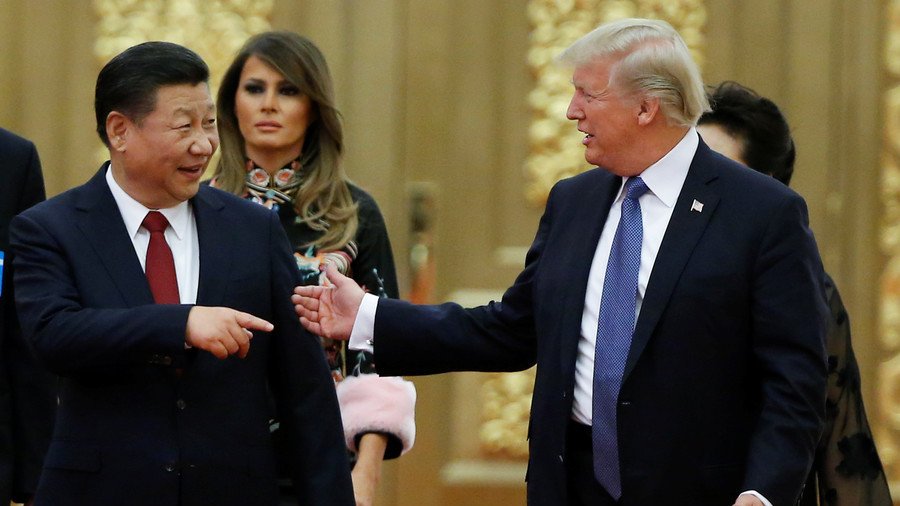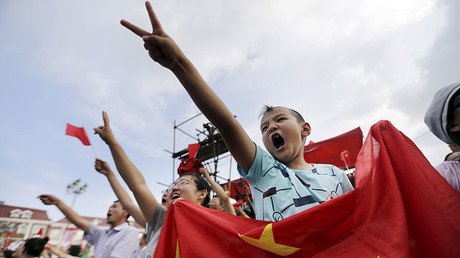Seeking a trade war and needing Beijing’s help with North Korea, Trump meanwhile has the US Navy challenging China in Taiwan and the South China Sea, leaving observers and his own staff wondering what he’s thinking.
(Hong Kong) – President Trump, like a proverbial bull in a China shop, has thrown global trade relations into turmoil by attacking long-standing international trade agreements such as NAFTA and the WTO which he says have been damaging to the US. He’s also threatening major trading partners in Europe and Asia, and notably China, with heavy tariffs on their exports if they don’t reduce their trade surpluses with the US.
It’s a little strange, one must admit — a bit like consumers condemning Walmart or Amazon for luring them into spending too much by selling them goods at too favorable a price — but that’s where things stand.
The Trump administration is telling China that unless it can slash its trade surplus with the US by some $200 billion a year by 2020, it will be socked with tariffs on its exports to the US. But US trade negotiators haven’t stopped there. They are also demanding, at least at this point in negotiations with Beijing, that China drop its plans for a government-funded program called ‘Made in China 2025.’ It’s aimed at using state funding of technology firms to push China into the lead in advanced technologies like artificial intelligence.
READ MORE: US wants China trade deal as talks resume, says White House adviser Kudlow
A country with a huge state-owned business sector, China has long relied on central planning and state funding to develop its economy and to raise the living standards of its 1.3 billion people. This approach has shown remarkable success, especially over the past three decades. Understandably China, while willing to talk about buying more US goods to reduce the country’s trade surplus with America, insists its ‘Made in China’ technology development plan is “non-negotiable.”
That’s going to be a huge problem for US-China trade relations going forward.
High wages in the US relative to China (and the rest of the developing world) have long meant that US manufacturing industries have had to massively boost productivity or shift into producing high-value-added products such as advanced high-end automobiles, aircraft or hydropower turbines — either that or move production abroad to low-wage countries.
Nations such as Germany, Sweden and Finland chose the high-value-added option, but most big manufacturers in the US, such as Westinghouse, GE and Apple, instead chose the offshore manufacturing route — an option which has only worsened the US trade balance while causing devastating high-wage job losses domestically.
As this shift occurred, US politicians and the “think tanks” of economists, who provide them with their ideological backing, have always argued that America would simply shift to having a knowledge-based economy. The problem is that it turns out — surprise, surprise — Asian, South Asian, African and South American workers are just as capable as, or perhaps more capable than American workers at becoming tech savvy. In fact, US technology companies such as Intel, Apple, Microsoft and others have been turning to those “backward” regions to hire the educated workers they need to do their R&D because they can’t find enough local talent graduating from US colleges.
So, turning back to the big trade dispute with China, the Trump administration appears to be attempting to do two difficult things simultaneously: 1) get China to buy more US goods, while selling the US less, and 2) toss out the window Beijing’s long-established state-enterprise-based, planned-economic model in favor of a free-market free-for-all model with little central government involvement.
It might be possible for China to buy more US goods — particularly agricultural products (which, it should be pointed out, benefit significantly from US government subsidies), but there the problem is a justified fear on China’s part of the US later turning around and using US sanctions to block deliveries of such critical products as rice, soybeans, corn and wheat after having made China dependent upon those imports.
In any event it’s clear that no amount of American negotiating pressure or threats of a trade war will cause China to give up its successful state-planning model when it comes to a big goal such as developing a world-beating high-technology industry.
What this means is that despite the bombastic rhetoric from Trump on the campaign trail, and even as president, about China’s being an unfair player on international trade, the US is in no position to do much about it.
Indeed, pushing China too hard could backfire, as has already become apparent in the case of the US auto, communications and high-tech industries – all of which depend upon parts obtained from Chinese suppliers. In a globalized economy with supply chains that span the globe, trade sanctions are a rather blunt tool to employ — one which can hurt the sanctioner as much as the sanctioned.
Meanwhile, President Trump appears to have picked a remarkably poor time to challenge China on trade, just as he is trying to reach a deal to denuclearize China’s neighbor and long-time ally North Korea. If any country has significant influence over North Korea, it is China, which besides supporting that country’s economy as its only significant trading partner, also has a mutual assistance treaty with Pyongyang under which China is pledged to come to North Korea’s aid if it is attacked.
Already, China is reportedly loosening up on trade sanctions it grudgingly put on North Korea at the urging of the US after Kim Jong-un’s regime conducted several nuclear tests and launched provocative long-range nuclear-capable missiles. If the US were to press too hard on trade, China could just drop what sanctions it has imposed on the North, allowing Kim take a harder stance in his negotiations with the US. (There are reports Chinese companies are already buying coal from North Korea again.)
There is, in other words, an erratic and self-contradictory character to US policy towards China, both on trade, and on military and strategic issues, not just in the Korean case, but also with respect to Taiwan and the South China Sea, two more areas of critical importance to China. It is in this region that the Trump administration has been taking belligerent positions — providing modern arms to Taiwan and sending US military vessels and large bombers provocatively close to Chinese island bases in the South China Sea.
Is China a valuable partner with which the US wants to amicably negotiate better terms of trade? It’s hard to see that happening if, at the same time, the US military is threatening China’s military positions just a short distance off the country’s southern coast, or providing better weapons to what China considers a renegade territory on the island of Taiwan.
Is China a country whose assistance the US wants in reaching a historic deal to finally end the 65-year-old Korean War and in convincing the now nuclear-armed North to give up its atomic bombs? It’s hard to see that happening if the US is also threatening China with a trade war that could plunge China into a recession and a destabilizing rise in joblessness.
While this seemingly schizophrenic US policy towards China could be the result of a deeply divided Trump administration, where globalist advisors seeking less conflict and neoconservative America Firsters seeking more conflict are vying for the president’s ear, it could also be a case of presidential attention deficit disorder and policy decision based on tweets.
How else can one explain the president’s sudden turnaround with a tweet late last week announcing his willingness to cancel punishing US sanctions placed on a Chinese tech giant, ZTE. The maker of cellphone and communications switching equipment is accused by the US of violating a US government embargo on the sending of technology products to Iran and North Korea. Trump had tweeted that he wanted to help ZTE, which had been facing possible bankruptcy because of US sanctions, to “get back into business fast.”
Trump’s move stunned his own advisors but was welcomed in China.
There is one major indication that all the talk of a looming trade war between the US and China may be more about Trump playing to his domestic political base than about any real plan to go mano a mano with China on trade – and that is the Hong Kong stock market. Trump promised to “bring back” the jobs of those manufacturing workers who lost their manufacturing roles in the so-called Great Recession of 2007-2009. They voted for Trump but the jobs have yet to return.
Always extremely sensitive to China-US relations thanks to the large number of listed companies that are either Chinese government enterprises, or Hong Kong-based firms heavily dependent on US-China trade, the Hang Seng rose steadily through the first turbulent year of Trump’s presidency, and this year, while off from its peak reached in January, is still up over 5 percent year-to-date.
The statements, views and opinions expressed in this column are solely those of the author and do not necessarily represent those of RT.



